 |
 |
 |
| |
Quality of Life Improved by SVR, Ifn-Free Therapy Improves Better
|
| |
| |
There are 2 studies in this report: the 1st reporting SVR improves fatigue and the 2nd also reports SVR "may be associated with health status" and that SVR improves quality of life & that patients receiving IFN-free regimens had better quality of life: depression, anxiety, fatigue.
Reported by Jules Levin
EASL 2014 April 9-13 London, UK
IMPROVEMENT OF CENTRAL FATIGUE IS ASSOCIATED WITH SUSTAINED VIROLOGIC RESPONSE (SVR) FOLLOWING SOFOSBUVIR (SOF) CONTAINING REGIMENS
Z.M. Younossi1,2, M. Stepanova2, L. Gerber1,2, F. Nader1,2, S. Frost1, S.L. Hunt1,2
1Center for Liver Diseases, Department of Medicine, Inova Fairfax Hospital, 2Betty and Guy Beatty Center for Integrated Research, Inova Health System, Falls Church, VA, United States
E-mail: zobair.younossi@inova.org
Background and aims: Fatigue, an important extrahepatic manifestation of HCV, is a complex condition that can be categorized into central fatigue (CF) and peripheral or physical fatigue (PF). The aim of this study is to evaluate the changes in fatigue in patients receiving SOF in FUSION and NEUTRINO clinical trials.
Methods: Fatigue was assessed using three validated questionnaires [FACIT-F (Functional Assessment of Chronic Illness Therapy-Fatigue), Chronic Liver Disease Questionnaire-HCV (CLDQ-HCV) and Short Form-36 (SF-36)]. Items related to fatigue were selected, normalized to 0-1 scale, and used for exploratory factor analysis. HCV-related fatigue items were selected: Peripheral Fatigue (9 items) and Central Fatigue (4 items).
Results: A total of 413 patients achieved SVR-12 after treatment with SOF regimens. After achieving SVR-12, significant improvement of fatigue (compared to patients' own baseline score) was noted using all instruments: vitality scale of SF-36 (VT): 26.9%; activity-energy domain of CLDQ-HCV (AE): 10.7%; fatigue scale of FACIT-F (FA): 19.8% (all p< 0.0001). Additionally, after achieving SVR-12, the proportion of patients who scored below the general population norm by at least Minimally Clinically Important Difference (MCID) decreased from 32.7% to 27.6% (VT), 47.9% to 35.4% (AE) and 43.4% to 34.6% (FA). Finally, compared to patients' baseline, all items related to CF improved (all p< 0.0015) while only 2 items related to PF showed moderate improvement (p=0.0202 and 0.0133, respectively).
Conclusions: SVR-12 is associated with improvement of fatigue. Additionally, central fatigue is primarily affected by HCV clearance. Longer follow up may be needed to show any potential improvement in peripheral fatigue.

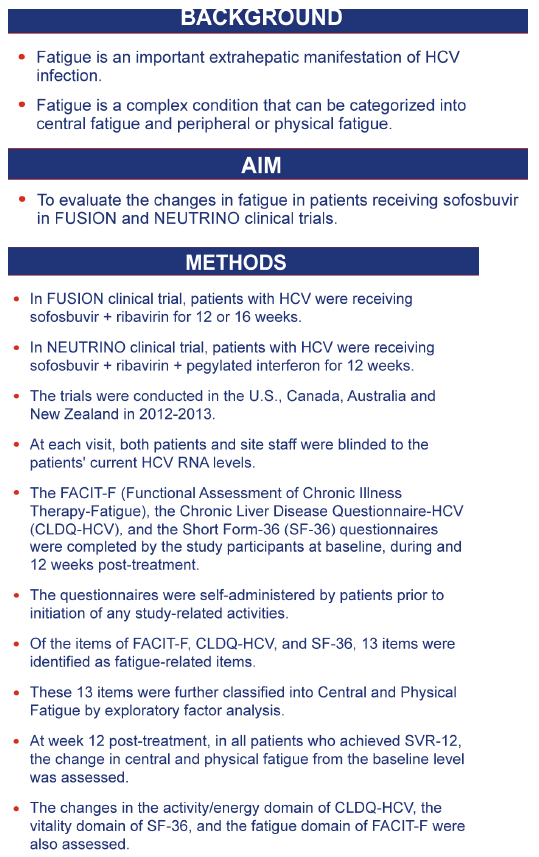
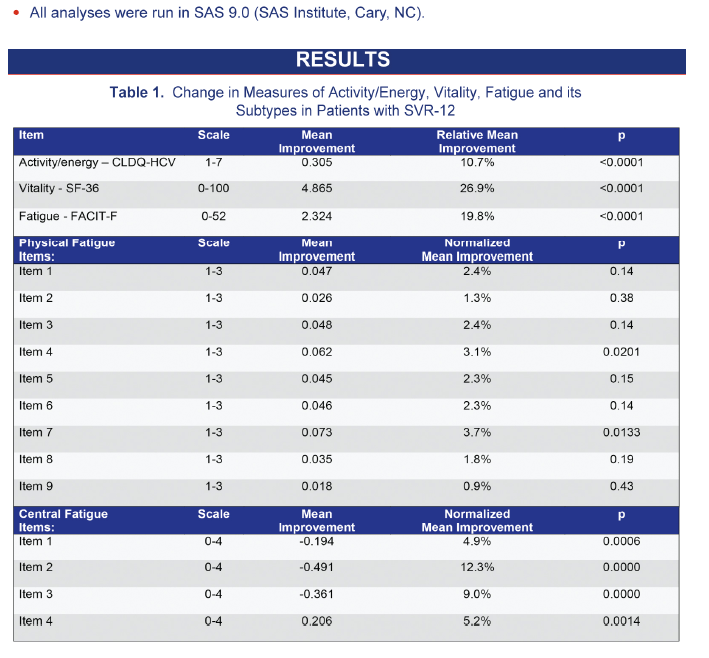
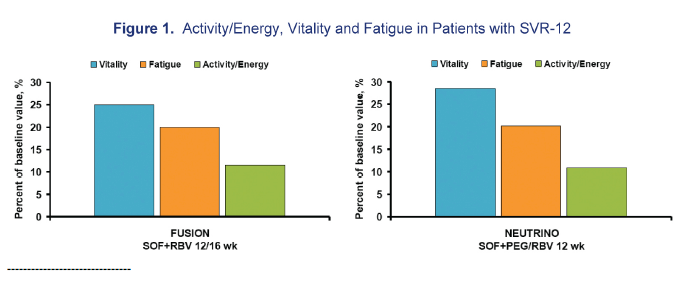
-------------------------------
ESTIMATING HEALTH STATUS USING EQ5D FOR CHRONIC HEPATITIS C (CH-C) PATIENTS TREATED WITH SOFOSBUVIR (SOF) CONTAINING REGIMENS
Z.M. Younossi1,2, M. Stepanova1, S. Cure3, F. Bourhis4, F. Nader1,2, S.L. Hunt1,2
1Betty and Guy Beatty Center for Integrated Research, Inova Health System, 2Center for Liver Diseases, Department of Medicine, Inova Fairfax Hospital, Falls Church, VA, United States, 3OptumInsight UK, Uxbridge, United Kingdom, 4OptumInsight France, Nanterre, France
E-mail: zobair.younossi@inova.org
Background and aims: Health status assessment with EQ5D is important for economic analysis and clinical trials. We estimated EQ5D scores for patients receiving SOF+ribavirin (RBV) with or without peg-interferon (PEG-IFN).
Methods: Using Short Form-36 (SF-36) and SF6D, we calculated EQ5D scores (Gray 2004) by a two-part direct mapping algorithm (baseline, end-of-treatment and post-treatment).
Results: 1,004 CH-C patients with SF-36 data were included [POSITRON (N=262), FISSION (N=215), FUSION (N=201), NEUTRINO (N=326)]. SF6D and EQ5D scores were calculated and highly inter-correlated (r=0.71 to r=1.0, p< 0.0001). Baseline EQ5D scores were 0.706±0.218 (POSITRON), 0.755±0.234 (FISSION), 0.749±0.221 (FUSION) and 0.793±0.219 (NEUTRINO). After treatment week 12, patients receiving SOF+RBV (POSITRON) had similar EQ5D scores to placebo (p>0.05). Furthermore, patients receiving 12 or 16 weeks of SOF+RBV had similar EQ5D scores (FUSION) (p>0.05). In FISSION, patients receiving PEG-IFN+RBV had substantially lower EQ5D scores compared to SOF+RBV (0.650±0.224 vs. 0.737±0.251, p=0.041). Patients receiving PEG-IFN+SOF+RBV (NEUTRINO) had a major decrease in their EQ5D scores during treatment (from 0.793±0.219 to 0.645±0.213, p< 0.0001) similar to scores observed in patients receiving PEG-IFN+RBV (FISSION) (from 0.771±0.236 to 0.650±0.224, p< 0.0001). After 12 weeks of follow-up, patients with SVR-12 (FUSION) showed significant improvement in EQ5D scores (+0.043 to the baseline, p=0.0127). In multivariate analyses, baseline depression, anxiety, fatigue, insomnia, treatment-related anemia and receiving IFN were predictors (p< 0.001) of lower EQ5D scores.
Conclusions: This is the first study estimating EQ5D scores from SF-36 in CH-C. EQ5D scores are minimally impacted by IFN-free SOF regimens. These patients had significantly higher EQ5D scores than those receiving IFN-containing regimens.
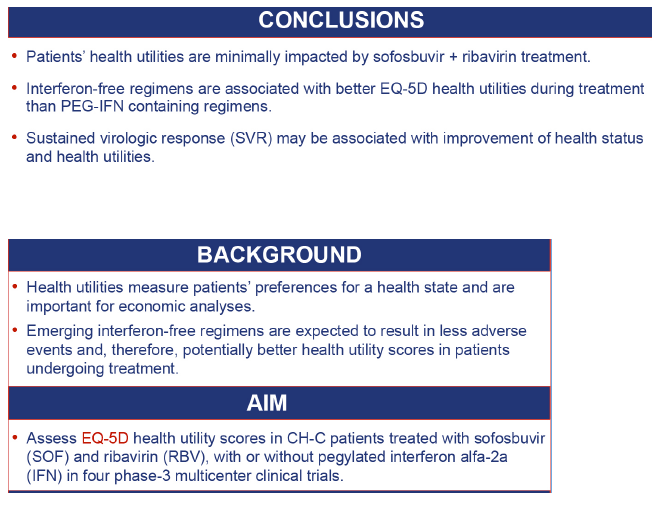
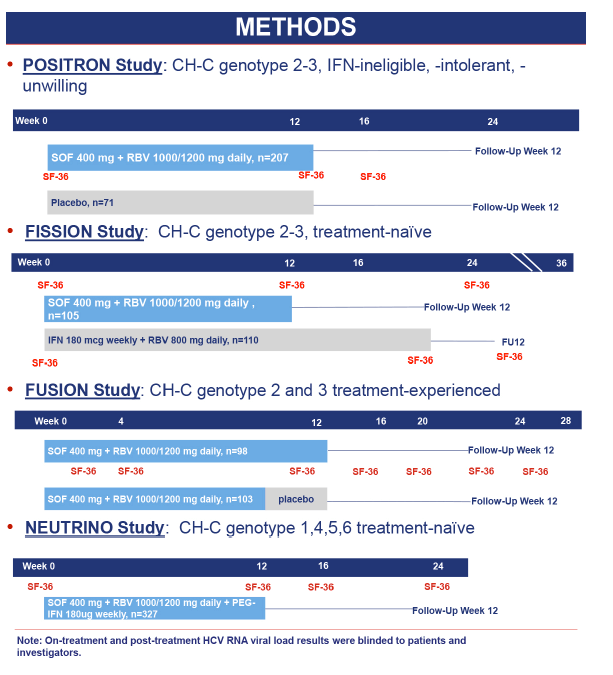

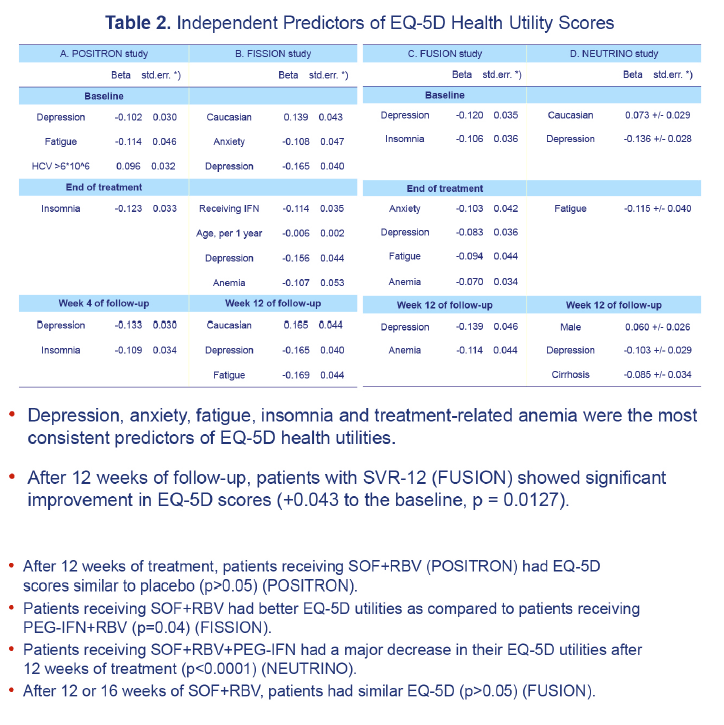

---------------------
INDEPENDENT PREDICTORS OF PATIENT-REPORTED OUTCOMES (PROS) AND QUALITY OF LIFE (QOL) IN CHRONIC HEPATITIS C PATIENTS RECEIVING INTERFERON (IFN)-FREE VERSUS IFN-CONTAINING REGIMENS WITH SOFOSBUVIR (SOF)
Reported by Jules Levin
EASL 2014 April 9-13 London UK
Z.M. Younossi1,2, M. Stepanova1,2, F. Nader1, D. Nelson3, E. Lawitz4, I.M. Jacobson5, E. Gane6, S.L. Hunt1,2
1Center for Liver Diseases, Department of Medicine, Inova Fairfax Hospital, 2Betty and Guy Beatty Center for Integrated Research, Inova Health System, Falls Church, VA, 3University of Florida, Gainesville, FL, 4Texas Liver Institute, University of Texas Health Science Center, San Antonio, TX, 5Weill Cornell Medical College, New York, NY, United States, 6Auckland City Hospital, Auckland, New Zealand

Program Abstract
Background and aims: IFN causes substantial impairment of QoL. We compared PROs and QoL between IFN-free and IFN-containing-SOF regimens.
Methods: 525 patients receiving IFN+RBV+SOF (NEUTRINO) or RBV+SOF (FUSION) completed PRO questionnaires: CLDQ-HCV (QoL), FACIT-F (Fatigue) and WPAI-SHP (work productivity and activity). Subjects were blinded to virologic data.
Results: Baseline depression/anxiety, insomnia and fatigue were similar between IFN-free or IFN-containing regimens (p>0.05). By the end-of-treatment, decrements in PRO scores were higher in those receiving IFN-regimen: physical well-being (decrement=18.9% IFN-based vs. 4.6% IFN-free, p< 0.0001), functional well-being (13.2% vs. 6.1%, p=0.0002), fatigue (19.4% vs. 2.7%, p< 0.0001), total-FACIT-F (12.2% vs. 2.4%, p< 0.0001), all domains of CLDQ-HCV (9.5% to 19.3% vs. 0.3% to -3.3%, p< 0.05), work productivity (23.2% vs. 5.7%, p=0.004) and activity impairment (22.2% vs. 6.5%, p=0.002). In multivariate analysis, predictors of poor PROs at baseline were depression (beta=-9.4 to -13.6%, p< 0.05) and fatigue (beta=-12.2 to -22.5%, p< 0.05). At the end-of-treatment, predictors of poor PROs included receiving IFN (beta=-4.7 to -13.2%, p< 0.05), depression (beta=-6.4 to -6.5%, p< 0.05), fatigue (beta=-10.9 to -16.5%, p< 0.05) and female gender (beta=-7.8 to -9.4%, p< 0.05). By follow-up week 12, predictors of poor PROs included depression, anxiety, fatigue and cirrhosis (p-values< 0.05). In subjects with SVR-12, predictors of residual PRO impairment included anxiety (beta=-5.4 to -7.0%, p< 0.05), depression (beta=-6.8 to -11.3%, p< 0.05), fatigue (beta=-8.0 to -12.4%, p< 0.05) and cirrhosis (beta=-4.4 to -11.8%, p< 0.05).
Conclusions: Fatigue and depression are the main drivers of PRO impairment. During treatment, IFN is another predictor of poor PROs.
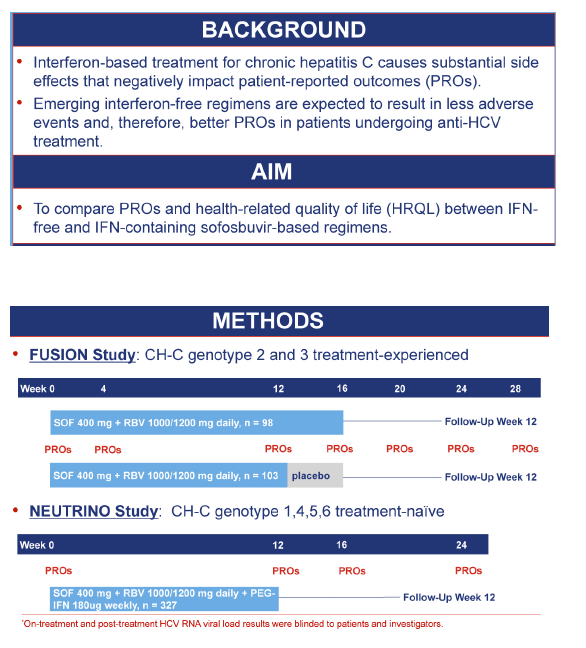
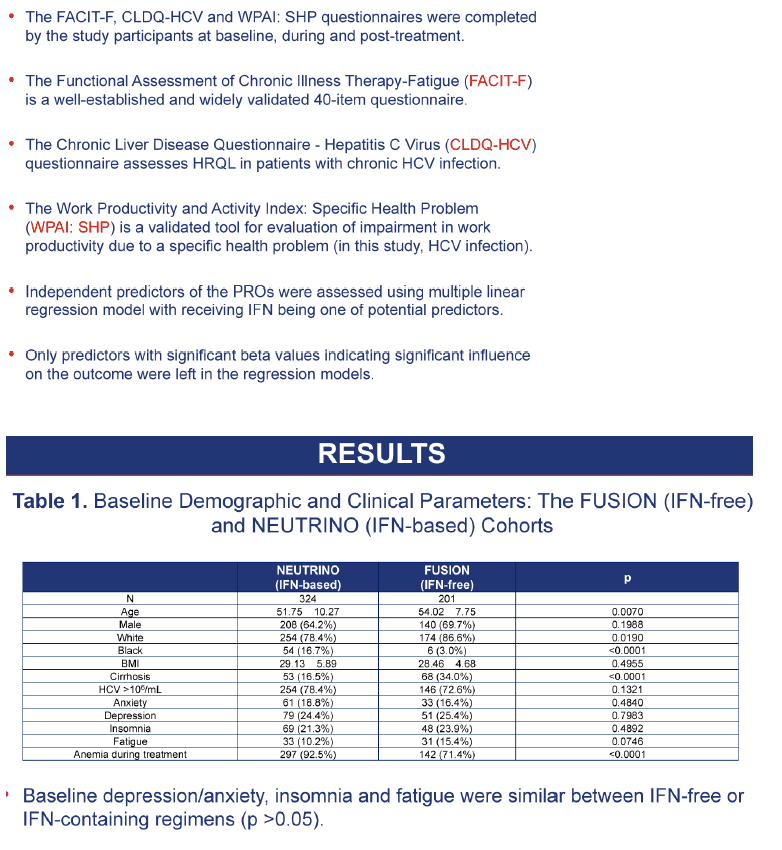
|
| |
|
 |
 |
|
|